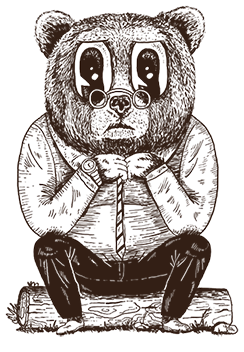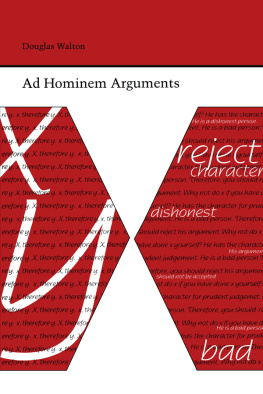
Cheer up this bear... visit
BookofBadArguments.com
Facebook.com/badarguments
PRAISE FOR

I love this illustrated book of bad arguments. A flawless compendium of flaws.
Alice Roberts, PhD, anatomist, writer, and presenter of The Incredible Human Journey
Bad arguments, great illustrations... gorgeous.
Cory Doctorow, BoingBoing.net
Seriously, An Illustrated Book of Bad Arguments should be on every school curriculum. Twitter will be a more civil place.
Kevin Tang, BuzzFeed.com
A great primer for anyone looking to understand logical fallacies... Pass it along to the arguersgood and badin your life.
Lauren Davis, io9.com
Now more than ever, you need this illustrated guide to bad arguments, faulty logic, and silly rhetoric.
Dan Solomon, Fast Company magazine online
Share [this book] with your friends. Encourage your family members to flip through it. Casually leave copies in public places.
Jenny Williams, GeekDad.com
[A] wonderful primer on the logical fallacies that have been screwing up our thinking... since shortly after the invention of dirt.
Ron Kretsch, DangerousMinds.net

AN ILLUSTRATED BOOK OF


ILLUSTRATIONS BY
Alejandro Giraldo

NEW YORK
An Illustrated Book of Bad Arguments (second edition)
Creative Commons  2013 Ali Almossawi
2013 Ali Almossawi
All material new to this edition copyright 2014 Ali Almossawi
This is a revised and updated second edition of An Illustrated Book of Bad Arguments (originally published by the author in 2013 at BookofBadArguments.com, under a Creative Commons Attribution-NonCommercial 3.0 Unported license).
All commercial rights, and all rights to the material new to this second edition, are reserved. No portion of this book may be reproduced, distributed, or transmitted in any form or by any means, electronic or mechanical, including photocopying, recording, or information storage or retrieval system, without the prior written permission of the publisher.
The Experiment, LLC
220 East 23rd Street, Suite 301
New York, NY 10010-4674
www.theexperimentpublishing.com
The Experiments books are available at special discounts when purchased in bulk for premiums and sales promotions as well as for fund-raising or educational use. For details, contact us at .
Library of Congress Cataloging-in-Publication Data:
Almossawi, Ali, author.
An illustrated book of bad arguments / Ali Almossawi ; illustrations by Alejandro Giraldo.
pages cm
Includes bibliographical references.
ISBN 978-1-61519-225-0 (cloth) -- ISBN 978-1-61519-226-7 (ebook)
1. Reasoning. 2. Fallacies (Logic) 3. Logic. I. Title.
BC177.A46 2014
168--dc23
2014016343
ISBN 978-1-61519-225-0
Ebook ISBN 978-1-61519-226-7
Cover design, art direction, and original text design by Ali Almossawi
Illustrations by Alejandro Giraldo
Additional text design by Pauline Neuwirth, Neuwirth & Associates, Inc.
Back cover design by Karen Giangreco
Manufactured in China
Distributed by Workman Publishing Company, Inc.
Distributed simultaneously in Canada by Thomas Allen & Son Ltd.
First printing August 2014
10 9 8 7 6 5 4 3 2 1
To Danaheverything
Contents
The first principle is that you must not fool yourself and you are the easiest person to fool.
Richard P. Feynman
Who Is This Book For?
This book is aimed at newcomers to the field of logical reasoning, particularly those who, to borrow a phrase from Pascal, are so made that they understand best through visuals. I have selected nineteen of the most common errors in reasoning and visualized them using memorable illustrations that are supplemented with lots of examples. My hope is that the reader will learn from these pages some of the most common pitfalls in arguments and be able to identify and avoid them in practice.
Preface
The literature on logic and logical fallacies is wide and exhaustive. Some of it aims to help the reader utilize the tools and paradigms that support good reasoning, and hence lead to more constructive debates. But reading about things that one should not do is also a useful learning experience. In his book On Writing, Stephen King writes, One learns most clearly what not to do by reading bad prose. He describes his experience of reading a particularly terrible novel as the literary equivalent of a smallpox vaccination [
This books novelty also lies in its use of lively illustrations to describe some of the common errors in reasoning that plague a lot of our present discourse. They are inspired in part by allegories such as Orwells Animal Farm and by the humorous nonsense of works such as Lewis Carrolls stories and poems. Unlike in such works, there isnt a narrative that ties the illustrations together; they are discrete scenes, connected only by style and theme, which better affords adaptability and reuse. Each of the fallacies has just one page of explanation, which I hope will make them easy to digest and remember.
Many years ago, I spent part of my time writing software specifications using first-order predicate logic. It was an intriguing way of reasoning, using mathematics rather than the usual notationEnglish. It brought precision where there was potential ambiguity and rigor where there had formerly been some hand-waving.
During the same time, I perused a few books on propositional logic, both modern and medieval, one of which was Robert Gulas Nonsense:A Handbook of Logical Fallacies []. That book reminded me of a list of guidelines that I had scribbled down in a notebook a decade ago about how to argue; they were the result of several years of arguing with strangers in online forums and they included, for example, Try not to make general claims about things. That is obvious to me now, but to a schoolboy, it was an exciting realization.
It quickly became evident to me that formalizing ones reasoning could lead to useful benefits such as clarity of thought and expression, improved objectivity, and greater confidence. The ability to analyze others arguments can also serve as a yardstick for when to withdraw from discussions that will most likely be futile.
Issues and events that affect our lives and the societies we live in, such as civil liberties and presidential elections, often cause people to debate policies and beliefs. Observing some of that discourse, one gets the feeling that a noticeable amount of it suffers from the absence of good reasoning.
Of course, logic is not the only tool used in debate, and it is helpful to be cognizant of the others. Rhetoric likely tops the list, followed by concepts such as the burden of proof and Occams razor (the principle that, when seeking to explain a phenomenon, one should not introduce any more conjecture than is needed, also known as the
Next page















 2013 Ali Almossawi
2013 Ali Almossawi